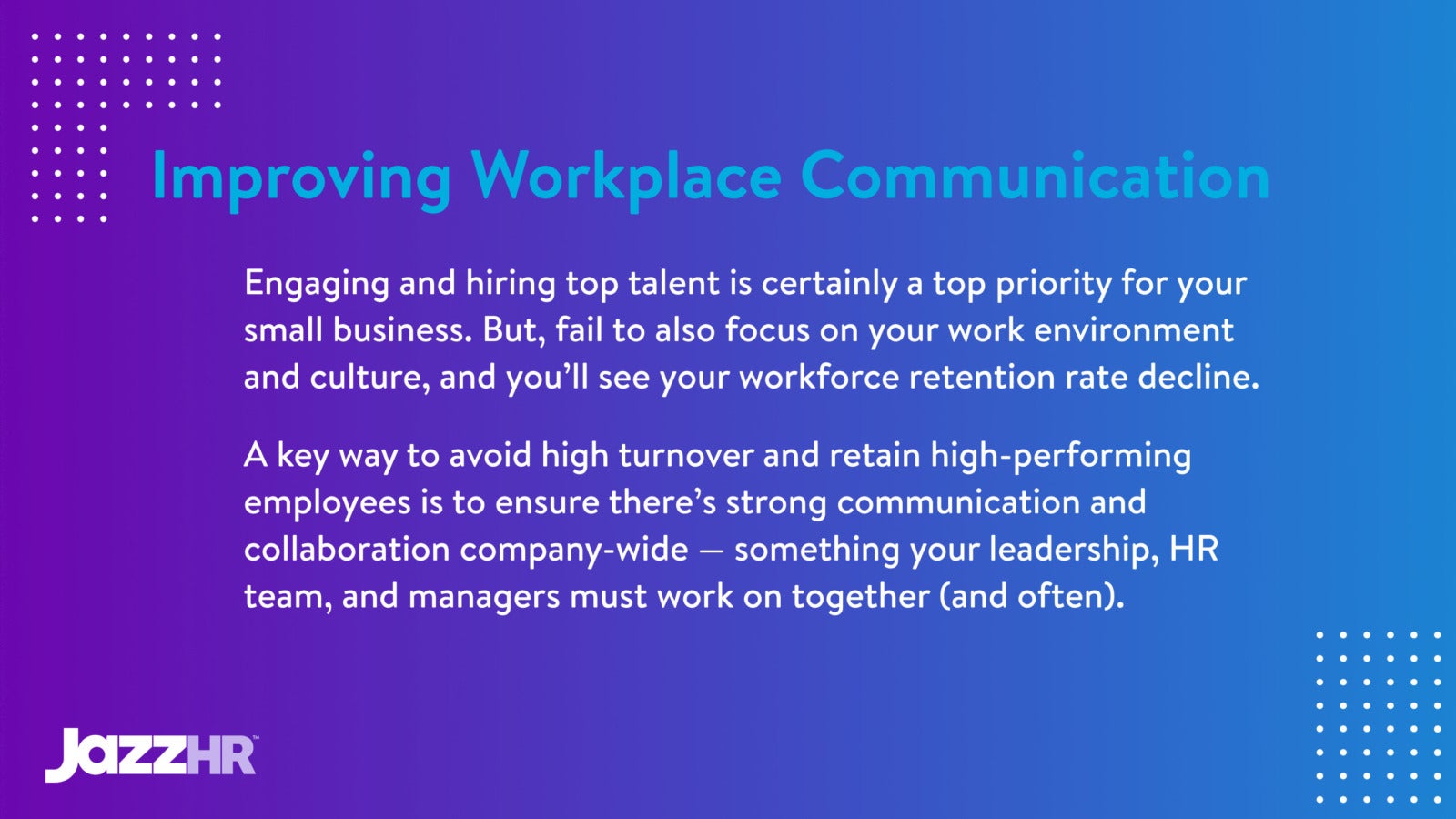Every organizational leader — including those running SMBs — are constantly focused on how to improve communication in the workplace. By doing so, they increase workforce output and productivity, which, in turn, leads to better business results and a gradually improving bottom line.
Knowing it’s vital to enhance communication in the workplace is one thing. Taking the necessary action to ensure highly efficient and effective inter- and intra-departmental communication and collaboration on key initiatives that can move the needle for your business is another.
11 ways to improve communication in the workplace
Thankfully, there’s a proven framework you can follow to not just improve communication at work, but also boost employee engagement and strengthen your company culture.
1) Organize enjoyable events outside the company
Communication does not always happen organically, as people who are separated by their responsibilities within a growing company may not interact regularly.
Planning outside events can help break those barriers and improve communication. There is a formality in the workplace that is not always conducive to communication, as separation in responsibilities and authority can discourage dialogue.
Therefore, organizing outside events that are away from the physical workspace can lessen tension, bring down physical barriers that exist in a business, and get team members to see each other as well-rounded people, not just fellow employees.
Doing so relaxes the environment for communication. By organizing outside events away from the business, you can bring in the human element that encourages communication that will extend into your growing org.
David Derigiotis, CIO, Embroker
2) Embed comms best practices in your onboarding
It’s challenging to ensure that communication stays efficient when your employee headcount is growing. More people means more emails or Slack messages; more people means more knowledge being shared, but potentially not being captured for the good of everyone, if the system isn’t set up optimally.
When onboarding new employees, it is important to run them through all your comms outputs and best practices. What information should they expect to learn/find from which outputs: all-hands meetings, newsletters, intranet, manager cascades?
If they have a codified sense of where comms should be, they can contribute and keep things running smoothly rather than posting questions or information in a forum that will get missed by others.
Scott Hitchins, CMO, Interact Software
3) Revisit your company’s communication protocols
As your company grows, it’s important to scale your communication effectively.
Establish clear communication channels and protocols that everyone in the organization can access and use. Use tools such as videoconferencing, instant messaging, and email to ensure that all employees can stay connected and up to date.
Regularly review and update communication policies and procedures to ensure they remain effective and efficient. Encourage open dialogue and feedback from all employees to ensure that everyone’s voice is heard. And ensure that everyone is aware of the company’s goals and objectives so they can work together to achieve them.
Carly Hill, Operations Manager, VirtualHolidayParty.com
4) Meet regularly for brief stand-up meetings
Have daily “stand-up meetings” to get an overview of what everyone is working on and capture existing obstacles at work. These stand-ups are time-boxed and informal, and five minutes should be enough for everyone in a growing team to share a point or two about their individual projects.
In this short time, everyone should be able to get enough context to remain informed with what the rest are working on. For efficient comms, brief yet impactful stand-up meetings are one way to go.
Max Wesman, Chief Operating Officer, GoodHire
5) Over-communicate with workers when possible
One thing that I can’t emphasize enough is the importance of over-communicating. In a remote or hybrid work setup, organizations need to be extra vigilant not to create a communication gap.
By over-communicating, you make sure that no critical information is lost. That being said, over-communication doesn’t mean sharing confidential information but effectively and repeatedly conveying the information to employees.
Every organization must have a communication plan in place, which essentially outlines diverse ways of communicating vital information across the teams.
Just sharing the info in a Slack channel won’t be enough. Send emails, personal messages, or set up online or offline meetings if required. Over-communication is better than under-communication.

Adit Jain, CEO & Co-Founder, Leena AI
6) Clarify your org’s values and adhere to them
Being clear about company values and sticking to them is crucial for improving communication at an SMB because it provides a clear, common ground and a shared understanding and language.
When an org always acts in alignment with its values, it earns the trust of its employees, partners, and customers, which is essential for effective comms, as it allows for open, honest dialogue.
It also establishes a culture of accountability. When company values are clearly communicated and upheld, it sets an expectation of accountability for all employees. This promotes efficient communication, as individuals are less likely to be evasive and dismissive in their conversation style.
What’s more, adhering to company values ensures all employees are working towards the same goals, which ensures that they share common ground and aren’t forced to verbalize all the minutest details.
Piotrek Sosnowski, Chief People & Culture Officer, HiJunior
7) Let senior management set the comms example
As a part of the senior management of my company, I can attest that the best way to ensure consistent and effective communication is for the senior management team to take the first step.
They should make it part of their role to keep all employees in touch with one another by, for example, hosting regular team meetings, having open office hours, and voicing messages out loud.
The senior team should also lead by example and practice real listening, assert obvious lines of responsibility, and show genuine interest in what their employees are bringing to the table.
This would pave the way for better vertical integration, enhanced collaboration across teams without silos, an open tone of constructive feedback, and eventually more efficient communication company-wide.
Derek Bruce, Sr. Director, Skills Training Group
8) Train all executives and other business leaders
As a growing company, it is essential to perfect leaders’ communication styles and practices in order to improve communication. Leaders serve as the primary models for communication. Their communication practices will be the foundation for how comms is conducted across the org.
Managers are disseminators of the communication practices. Their ability to effectively communicate is key to ensuring that all employees understand and implement the communication practices.
As the org expands, it is important to ensure that leaders are equipped with the necessary skills and resources to effectively communicate with their teams and other stakeholders.
With effective, open communication practices in place, your small business will be better prepared to face the challenges and opportunities that come with growth. (Not to mention ensure all employees feel comfortable to share their thoughts about business concerns tied to their work.)
Grace He, People & Culture Director, teambuilding.com
9) Switch over to asynchronous communication
Relying on weekly team meetings for communication is fine 20 or 30 employees. It’s downright impossible, though, as you grow beyond that. Your employees will spend more time updating each other in meetings than actually doing the work.
I’ve seen this happen repeatedly at companies I’ve worked at in the past. In my current company, we use written (Slack) and video (Loom) updates to share info with each other. This is especially helpful in the remote work era and gives team members a choice over which updates apply to their job.
Moreover, this has freed up our calendars without becoming disconnected. Every employee can share insights and info with colleagues for whenever they get back online.
Julian Schaaf, Head of Marketing, Gomada
10) Schedule all-hands meetings and stick to them
When a company is small and numbers only several dozen employees, maintaining communication is relatively straightforward and rarely requires any additional effort. However, rapid growth can put communication on the back burner and lead to breakdowns in operation.
One way to prevent this is by organizing all-hands meetings each month, where employees can get direct and undiluted information from the source and engage in active listening with one another.
Monthly meetings are so effective at keeping communication alive because they give everyone a chance to hear more about different people within the company and learn who to contact with future queries. These group chats bring separate teams together and help people get to know each other.
Goran Luledzija, CEO, Localizely
11) Build a robust employee knowledge database
Build and regularly update a virtual employee knowledge base. Employees should be able to access instructions or informational documents like files and spreadsheets whenever needed, so give them a 24/7 space to easily access these answers.
While you can’t predict every question an employee has or replace meetings with a team FAQ database, you can help reduce the need for some of these more repetitive communications, so they have many of these answers available instantly at their fingertips.
Regularly ask employees to submit questions they think will help themselves or their teammates and update the data to keep up with developing standards and strategies.
Tory Gray, CEO & Founder, The Gray Dot Company
Learn how you can improve your SMB hiring team’s communication and collaboration with JazzHR.







